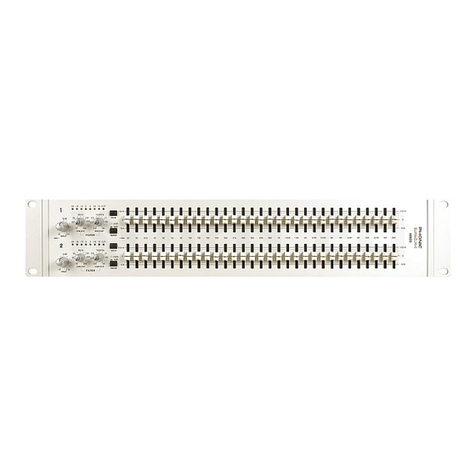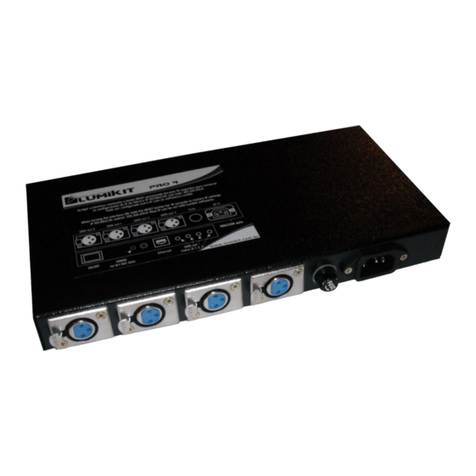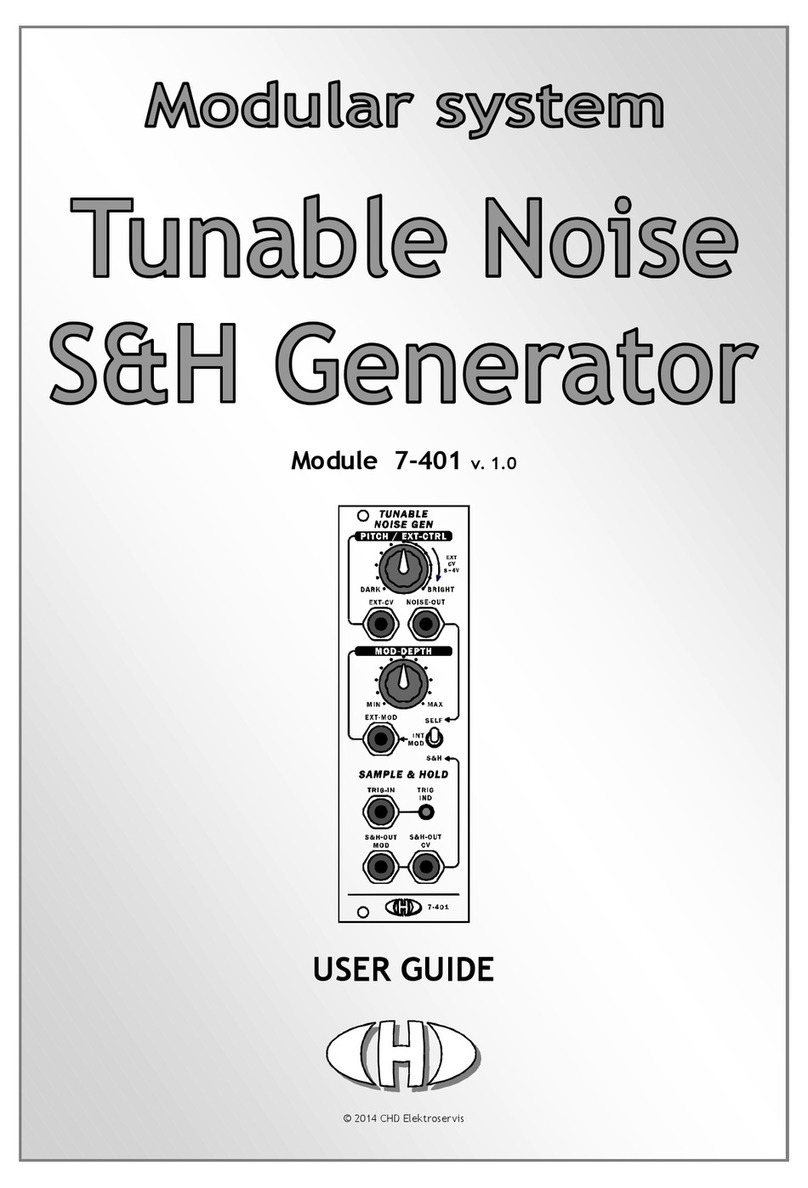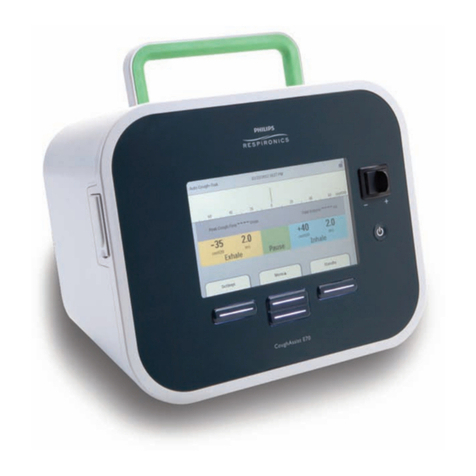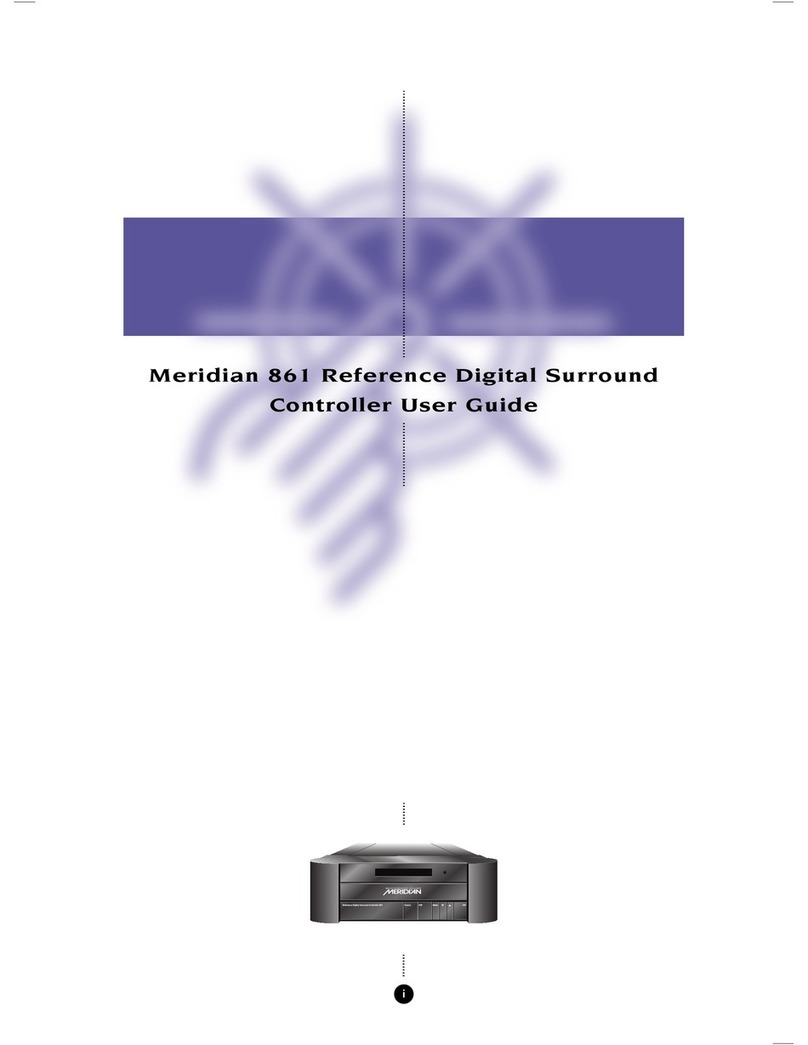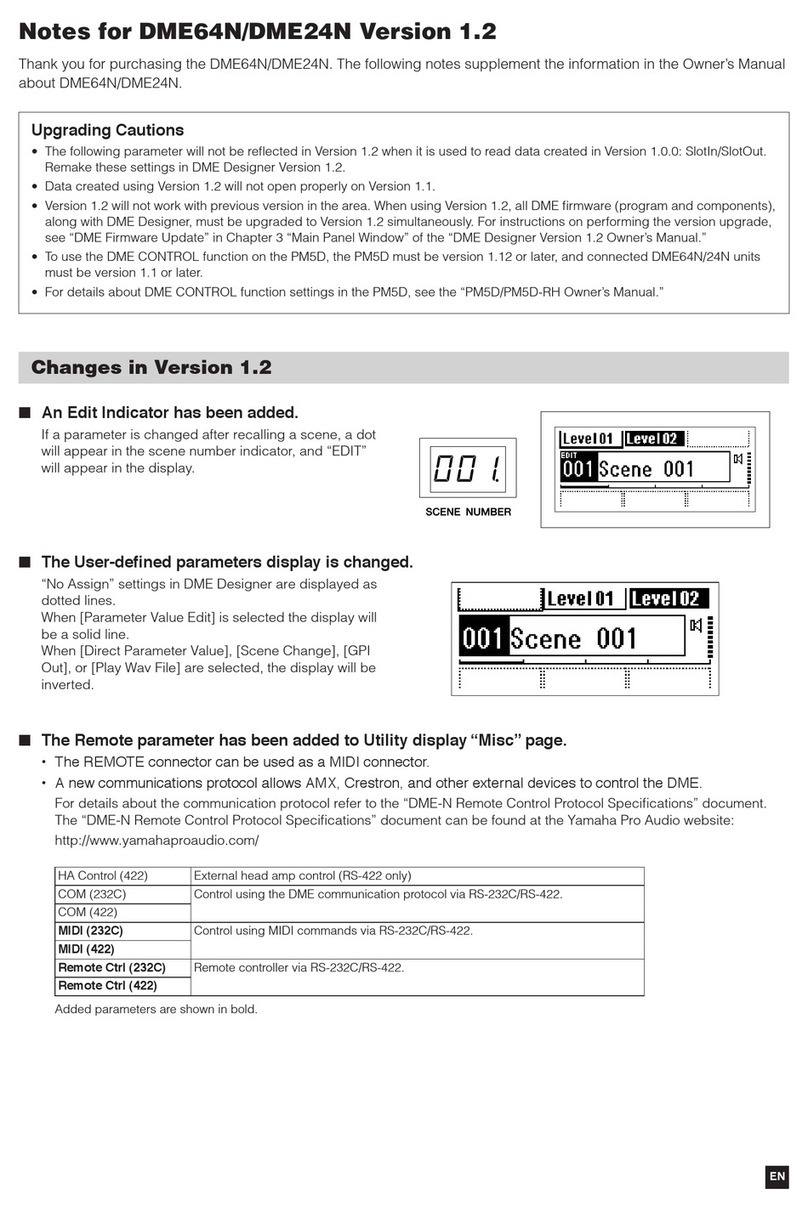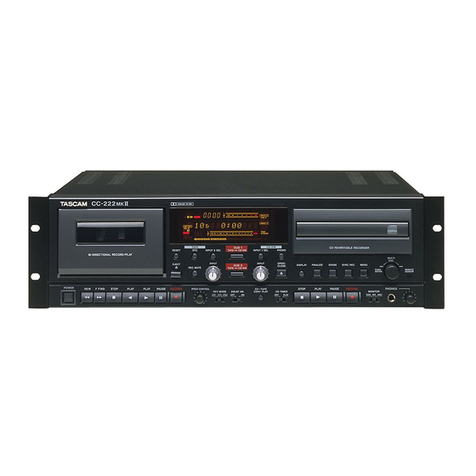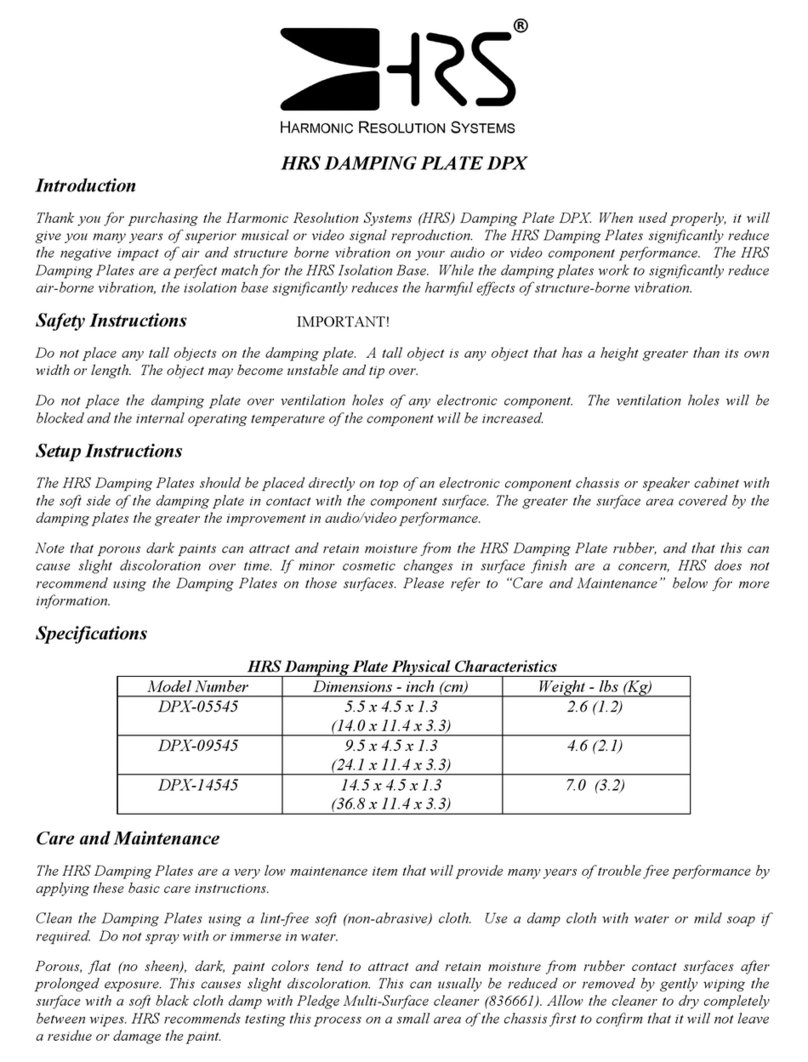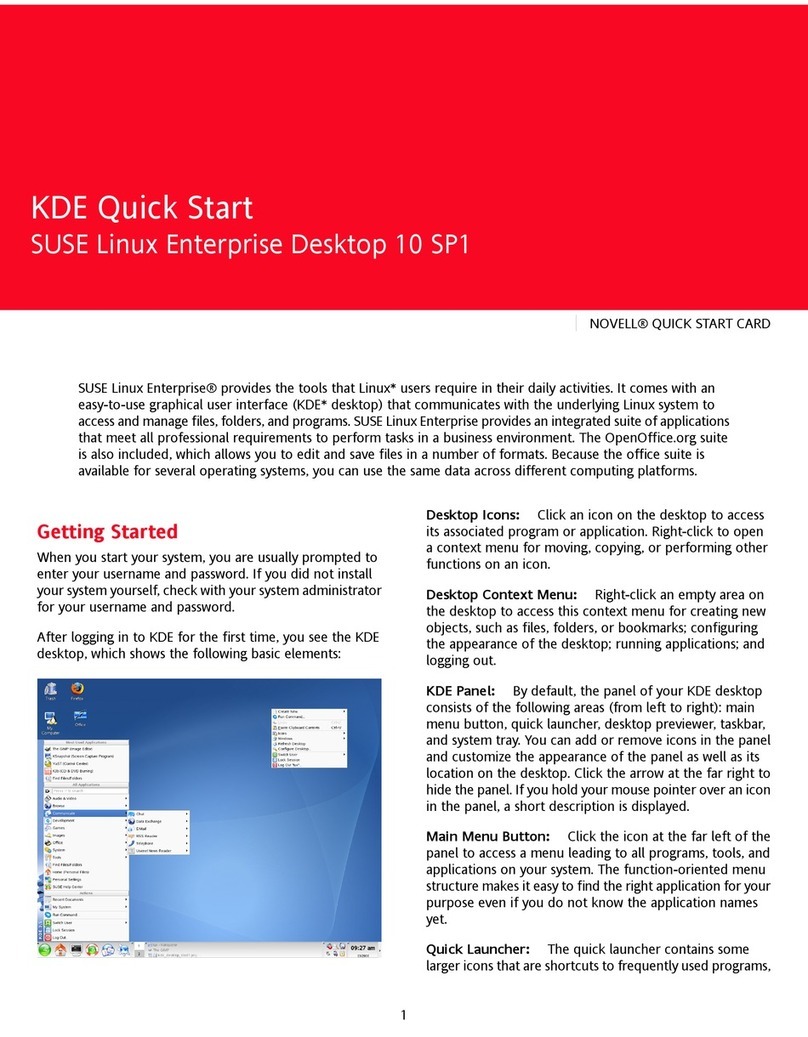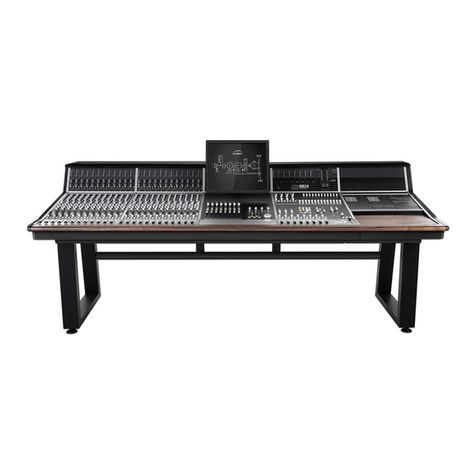Phonic MM1705a User manual


PHONIC CORPORATION
Page 2 MM1705a USER
’
S MANUAL
This triangle, which appears on your com-
ponent, alerts you to the presence of
uninsulated “ dangerous voltage” inside
the enclosure that may be sufficient to
constitute a risk of shock.
This triangle, which appears on your
component, alerts you to important op-
erating and maintenance instructions in
this accompanying literature.
SAFETY PRECAUTIONS!
WARNING - TO REDUCE THE RISK OF FIRE OR ELECTRIC SHOCK, DO NOT
EXPOSE THIS UNIT TO RAIN OR MOISTURE.
Do not allow water or liquids to be spilled into this unit. If the unit has been exposed to rain or liquids,
please unplug the power cord immediately from the outlet (with DRY HANDS) and get a qualified service
technician to check it. Keep this unit away from heat sources such as radiators, heat registers, stoves,
etc. that produce heat.
The unit contains no user-serviceable parts. Refer all servicing to a qualified
CAUTION:
TO REDUCE THE RISK OF ELECTRIC SHOCK, DO NOT REMOVE COVER (OR
BACK). NO USER-SERVICEABLE PARTS INSIDE. REFER ALL SERVICING TO
QUALIFIED SERVICE PERSONNEL.
Keep this unit clean by using a soft dry brush and occasionally wiping it with a damp cloth. Do not use any
other solvents, which may cause damage to paint or plastic parts. Regular care and inspection will be
rewarded by a long life and maximum reliability.
Your Phonic MM1705 was carefully packed in the factory and the packing box was designed to protect the
unit from rough handling. We recommend that you carefully examine the packaging and its contents for any
signs of physical damage, which may have occurred in transportation.
If the unit is damaged: Notify your dealer and the shipping company immediately. Claims for damage or
replacement may not be granted if it is not reported properly or in a timely manner.
SAFTY PRECAUTIONS
service engineer through a Phonic dealer.

PHONICCORPORATIONPage 3
MM1705aUSER
’
SMANUAL
INTRODUCTION............................................4
FEATURE S...............................................4
GETTINGSTARTED.......................................4
CONVERTINGTORACKMOUNTMODE...........5
CONNECTINGITUP.................................6
TYPICALCONNECTINGLEADS.....................7
UNBALANCED&BALANCED.........................8
CHANNELSTRIPDESCRIPTION.....................9
GAIN................................................................9
EQUALIZERS....................................................9
AUX/EFXSECTION........................................10
PAN..................................................................10
PEAK/-20/PFL.................................................10
L/RORGP(ROUTINGSWITCH).......................11
CHANNELFADER............................................11
STEREOCHANNELS6-11.................................12
AUXRTN.........................................................12
EFXRTN.........................................................12
2TRTN............................................................12
MASTERSECTIONDESCRIPTION.............13
AUXOUT...................................................13
EFXOUT..........................................13
PHONES....................................................13
GROUPTOL/R.........................................13
GROUP1/2FADER.............................13
MASTERDISPLAY...........................14
MONOLEVELCONTROL.........................14
MAINL/ROUTPUTFADER..........................14
REAR PANELDESCRIPTION........................14
PHANTOMPOWERSWITCH......................14
POWERSWITCH........................................14
INITIALSETUP.....................................15
APPLICATIONS.....................................16
1:LIVESOUND REINFORCEMENT............16
2:SUBMIXING............................................17
3:MUSICCLUB..........................................18
DIMENSIONS.................................................19
SPECFICATIONS............................................20
SYSTEMBLOCK DIAGRAM....................21
APPEND IX:.........................................22
1:SUGGESTEDREADING....................22
2:GLOSSARY.......................................23
CONTENTS
pP
Phonicreservesthe righttoimproveoralteranyinformation supplied withinthisdocumentwithoutprior
notice.V1.1Nov.19,2002

PHONIC CORPORATION
Page 4 MM1705a USER
’
S MANUAL
INTRODUCTION GETTING STARTED
1. Check the AC voltage before connecting the plug.
This product is equipped with a 3-wire grounding
type plug; this is a safety feature and should not
be defeated. Proper grounding must be practiced
to prevent electrical shock to the operator, the
microphone user, and any musicians whose in-
struments are wired to this unit. Choose the main
supply for the sound system with care, and do
not share sockets or earthing with light dimmers.
2. Position the mixer where the sound can be heard
clearly; preferably with the audience.
3. Run audio cables separately from dimmer wir-
ing, using balanced lines wherever possible. If
necessary, cross audio and lighting cables at
right angles to minimize the possibility of inter-
ference. Keep unbalanced cabling as short as
possible.
4. Check your cables regularly and label each
end for easy identification.
5. Before switching on the main power, keep all the
output faders all the way down to prevent dam-
age or excessive noise caused by bad level ad-
justment, wrong wiring, defective cables,or bad
connections.
6. Always turn on the MM1705a mixer before the
power amplifier; turn off the MM1705a mixer after
turning off the amplifier.
7. Always turn off the power before connecting or
disconnecting the unit.
8. Never use solvents to clean the unit. Clean with
a soft, dry cloth.
INTRODUCTION / FEATURES / GETTING STARTED
Congratulations on your purchase of the MM 1705a
Mixer. The MM 1705a is built of rugged construc-
tion, it can be mounted on a standard 19-inch ack,
which is ideal for both touring and fixed PA installa-
tions. In order to get the best performance from the
MM 1705a, please read this user manual carefully,
and retain it for later reference. If you ignore the
manual and directly jump into the unknown, some-
thing might happen and makes a fool out of you.
Please, at least find out what things are different
about this mixer and check if you are familiar with
all its features even if you are an experienced mixer
board user.
FEATURES
z5 balanced microphone/line input channels,
two with insert points
z3 stereo line input channels
z2 stereo line returns
z2T input and recording output
z1 aux and 1 effect mix send
z3 band EQ for each line input channels
zPFL for input, AFL for output
z60mm high quality linear faders
zDual 13-segments LED level meter
z2 audio groups
zStereo main output
zMono main output
z+48V phantom power
z-20/PFL, PEAK indicators on each input chan-
nel
zAUX SND can be set in PRE or POST fader
zLow cut filter on each mono input channel

PHONIC CORPORATION Page 5
MM1705a USER
’
S MANUAL
CONVERTING TO RACKMOUNT MODE
There is an option to meet the requirements of the
engineer who prefers to use a mixer that is installed
on a standard 19”rack. It is simple to install the rack
mount kit by the following procedure:
1. Install the rack mount kit with the 6 screws num-
bers 1-6.
2. Install the mixer on the rack.
CONVERTING TO RACKMOUNT MODE

PHONIC CORPORATION
Page 6 MM1705a USER
’
S MANUAL
CONNECTING IT UP
CONNECTING IT UP

PHONIC CORPORATION Page 7
MM1705a USER
’
S MANUAL
TYPICAL CONNECTING LEADS
TYPICAL CONNECTING LEADS

PHONIC CORPORATION
Page 8 MM1705a USER
’
S MANUAL
UNBALANCED & BALANCED
UNBALANCED & BALANCED
Unbalanced & Balanced Connection
Most of the mistakes in audio installations are be-
cause of incorrect and defective audio connections.
In order to perfectly complete your installation; please
pay special attention to the following section unless
you are already familiar with balanced/unbalanced
operations.
What is an unbalanced system?
You can find this kind of system in most of home
audio-video systems. They have one conductor to
carry the signal, and another conductor for a ground.
Normally, for lower level signals, the ground conduc-
tor shields the signal conductor.
What is a balanced system?
A balanced system transmits the signal via 2 con-
ductors plus one ground shielding conductor. The 2
signal conductors carry the same signal but out of
phase. For the balanced input stage, the amplifier
will boost the difference of the 2 signal conductors
and remove the identical part (known as common
mode signal) of the 2 signals . Because the real sig-
nal is carried by the 2 conductors out of phase, so it
is perfectly carried to the input. At the same time,
interference that occurs during transmission will be
identical (common mode). Because the signal con-
ductors are run together, there is no chance they
can be different, and all the interference will be re-
moved by the balanced input amplifier.
The difference between 2 operations:
Because of the common mode interference immu-
nity of a balanced system, the ground conductor
doesn’t need to carry any electrical current, which
means the ground of the 2 connected units has an
identical ground level which is vital to an interference
free system. Let’s look back to the unbalanced sys-
tem. The signal electrical current goes from the sig-
nal conductor to the ground conductor, and that
means the ground level of the 2 connected units are
not identical. This means the system is much easierto
experience noise interference.Running long cables
is easy for a balanced system but difficult for an
unbalanced system, and lower noise levels are a con-
stant characteristic of a balanced system. Because
a balanced system needs 2 conductors for the signal
and 1 conductor for the ground, a minimum of 3 con-
ductors are needed for wiring a balanced system. So
a dedicated system separates the ground and shields
the 2 conductors.
Please read following section for properly wiring bal-
anced and unbalanced systems:
The Correct Wiring for Balanced Operation
Always connect the main power with 3 plugs. Make
sure the power system ground is working properly.
Don’t use a ground insulator plug adapter without
properly connecting the ground individually. This is
vital to making a successful audio system connec-
tion.
Always connect the ground pin (PIN 1 in XLR) to the
source unit, and disconnect this pin on the destina-
tion unit. This connection topology is to avoid creat-
ing a grounding loop between the signal and power
ground. Utilize only the power ground, because it al-
ways has a lower resistance and better distribution
than the signal ground.
If there is hum, a possible reason is a bad ground
connection for the system. In case you can not find
the fault, try connecting the ground pin of the input
connectors. If the hum is reduced or eliminated, check
your power grounding system. Special attention is
needed when you use the equipment racks with some
distance between them, and/or use a large quantity
of power amplifiers. Check the power ground between
the racks and power distribution strips with your elec-
trical supply engineer. Make sure there is one, and
only one, proper ground point for the audio system
(or connected video system).
aaaaaaaaaaaaa
aaaaaaaaaaaaa
aaaaaaaaaaaaa
aaaaaaaaaaaaa
aaaaaaaaaaaaa
aaaaaaaaaaaaa
aaaaaaaaaaaaa
aaaaaaaaaaaaa
aaaaaaaaaaaaa
aaaaaaaaaaaaa
aaaaaaaaaaaaa
aaaaaaaaaaaaa
aaaaaaaaaaaaa
aaaaaaaaaaaaa
aaaaaaa
aaaaaaa
aaaaaaa
aaaaaaa
aaaaaaa

PHONIC CORPORATION Page 9
MM1705a USER
’
S MANUAL
CHANNEL STRIP DESCRIPTION
Two inputs are available to the mono
input channel, via an XLR connec-
tor (normally for microphone
sources) or a 3-pole 1/4” phone jack
for higher level signals such as key-
boards, drum machines, synths or
tape machines. Both input sockets
are permanently active, and may be
used by simply plugging the source
into the required input. You do not
need to unplug something from the
mic socket if you want to use the
line input. When both the micro-
phone and line signals are plugged
into any channel from CH1 to CH5,
then the circuit will automatically be
switched to line source.
An unbalanced INSERT is offered
which is a break point in the input
channel signal path. It allows the
signal to be taken out of the mixer,
through an external device and then
brought back into the console to
continue through to the final output.
The insert is a 3-pole 1/4” phone
jack, which is normally by-passed.
When a jack plug is inserted, the
signal path is broken at a point just
after the high pass filter, but before
the EQ section. The signal from the
channel appears on the TIP of the
phone plug and is returned on the
RING. The insert point allows com-
pressors, limiters, effect and other
signal processing units to be added
as required to particular input chan-
nels and because it is located PRE
EQ, noise generated by the exter-
nal equipment may be reduced by
a high frequency cut of 15dB in the
equalizer. Only channel 1&2 feature
with inserts.
1 GAIN
This rotary knob adjusts the channel
signal level. Too high, and the signal
will distort as it overloads the channel.
Too low, and the level of back hiss will
be more noticeable and you may not
be able to get a high enough signal level
to the output of the mixer. Proper gain
or gain settings allow the mixer to work
at the best operating level. Adjust the
gain when there is a signal present to
the highest level without triggering the
peak LED. That is the most appropri-
ate position.
This gain adjuster has two indications
to match either a microphone or line
input signal. When you use the micro-
phone input, please refer to the inside
ring from 0~+60 dB; but when you use
line input, please refer to the outside
ring from -20~+40dB.
If you use a condensor microphone,
it is required to send phantom power
to it. The global phantom power
switch is located on the rear panel.
All faders (Group 1, Group 2, Mono,
L/R and CH1~11) should be all the
way down when you switch on the
phantom power. In order to prevent
excessive noise to stage monitor
speakers and main speakers, phan-
tom powered mics should be plugged
in after the phantom power is switched
on.
2 EQUALIZERS
These equalizers are designed to suit
different room acoustics, control feed-
back and improve the live PA sound.
No amount of equalization will correct
the frequency response curve of a poor
loudspeaker. Always begin with all con-
trols in the “0” position and avoid ex-
cessively cutting/boosting large seg-
CHANNEL STRIP
DESCRIPTION

PHONIC CORPORATION
Page 10 MM1705a USER
’
S MANUAL
CHANNEL STRIP DESCRIPTION
ments of any particular frequency,
which will limit the system’s dy-
namic range or increase the possi-
bility of an unpleasant feedback
sound.To make sound more impres-
sive, a dynamic process is neces-
sary. Channel inserts are designed
to add-on a compressor, limiter or
gate. Please refer to Phonic
PCL3200 or MCL2000 for further in-
formation.
HIGH
Each input channel of the MM1705
has a three-band EQ. Turn the HIGH
to the right to boost high frequency,
adding crispness to cymbals, vocals
and electronic instruments. Turn to
the left to cut this frequency, reduc-
ing sibilance or hiss. The control has
a shelving response that gives 15dB
of boost or cut at 12KHZ.
MID
This knob provides 15dB of boost
and cut at 2.5k Hz, similar to the
High EQ knob.
LOW
The control has a shelving response
that gives 15dB of boost or cut at
80Hz. Add warmth to vocals or ex-
tra punch to guitars, drums and
synths by turning to the right. Turn
to the left to reduce stage rumble,
hum or to improve a mushy sound.
LOW CUT (CH1~5 only)
Slide down the dip-switch, insert the
18dB per octave 75Hz low cut filter
in the signal path. This low cut filter
is useful with live vocals to reduce
stage rumble or popping from Mics.
It can also be used to cut off low
frequency hum.
3 AUX / EFX SECTION
These rotary faders send out the input
channel signal to AUX or EFX buses.
These are used to set up separate
mixes for a foldback system and exter-
nal processing machines and
recording.The AUX send can be set as
either pre-fader (so that the aux send is
independent from the fader, which is
suitable for foldback or monitor) or post-
fader (which is suitable for the proces-
sor unit; the effect signal will fade up
and down with the fader). PRE or POST
AUX signal is selected by a push but-
ton.
The EFX send is always post-fader and
both AUX Send and EFX send are post
EQ.
4 PAN
This control sets the amount of the
channel signal feeding the left and right
mix buses, and allows you to locate the
source smoothly across the stereo im-
age. When the control is turned fully
right or left, you are able to route the
signal to either left or right output.
5 PEAK / -20 / PFL
PEAK
The LED indicators light up when an ex-
cessively high signal level is present in
the channel. In general, Input level
should be set to the level where the LED
flashes briefly on the loudest peaks
only, if it flashes continuously, turn the
input control down slightly. This ensures
the best possible signal-to-noise ratio
and dynamic range.

PHONIC CORPORATION Page 11
MM1705a USER
’
S MANUAL
CHANNEL STRIP CHANNEL
-20
The LED will come on if the channel
receives a signal input higher than -
20 dBu. Both the -20 dBu and the
PFL share the same indicator.
PFL
Pre-Fader-Listening, when the PFL
switch is pressed, the pre-fader sig-
nal will be fed to the control room/
headphone output, where it replaces
the selected monitor source. PFL is
very useful for a mixing engineer to
monitor individual channels without
affecting the main mixes, for mak-
ing adjustments or tracing problems.
6 L/R OR GP (ROUTING SWITCH)
The input channel signals may be
routed in stereo to the main output
(L/R) or pairs of Group busses (1-2),
by pressing the routing button. The
PAN will also affect the signal route.
Turning extremely left can only feed
Group 1 and extremely right only
feed Groups 2.
7 CHANNEL FADER
A long-throw 60mm linear fader de-
termines the proportion of the chan-
nel in the mix and provides a clear
visual indication of channel level.

PHONIC CORPORATION
Page 12 MM1705a USER
’
S MANUAL
CHANNEL STRIP DESCRIPTION
These 3 stereo input channels are designed
for a stereo line level signal, from a stereo
source such as keyboards, drum ma-
chines, synths, hi-fi equipment or DAT play-
ers. They have the same function as mono
channels except for GAIN setting and bal-
ance adjustment. These high impedance
inputs accept 2-pole phone jacks. Use
these inputs for keyboards, drum ma-
chines, synths, tape machine or process-
ing units. If the source signal is mono
please plug into the left channel socket
only. All of functions are the same with the
mono input channel strip.
8 AUX RTN
The AUX RTN control section includes one
knob and one PFL push button. The knob
controls the AUX RTN level. When you
would like to monitor the signal of AUX RTN,
simply depress the PFL button, the input
signal will be fed into CTRL RM.
9 EFX RTN
The EFX RTN control section includes one
knob and one PFL push button. The knob
controls the EFX RTN level. When you would
like to monitor the signal of EFX RTN, sim-
ply depress the PFL button, the input sig-
nal will be fed into CTRL RM.
10 2T RTN
This knob controls the level sent to the mas-
ter L/R. When you would like to monitor the
signal from the 2T RTN, simply depress the
PFL button, the input signal will be fed into
CTRL RM.
STEREO CHANNELS 6-11

PHONIC CORPORATION Page 13
MM1705a USER
’
S MANUAL
11 AUX OUT
This control routes a mono sum of the input
channel signal to the AUX bus. It is sepa-
rate from the master L/R outputs and can
therefore build additional mix output for the
stage monitor, effect unit or extra loudspeak-
ers.
12 EFX OUT
This control routes a mono sum of the input
channel signal to the EFX bus. It is sepa-
rate from the master L/R outputs and can
therefore build additional mix output for the
effect unit.
13 PHONES
This knob controls the CTRL RM/headphones
level output.
14 GROUP TO L/R & AFL
GROUP TO L/R
You can assign the GROUP 1/2 signal to
MAIN L/R. If you depress the L/R or GP but-
ton of any input channel then the input sig-
nal will be fed to GROUP 1/2. Moreover, if
you would like the input channel signal to be
mixed by the MAIN L/R, then it is nessary to
depress the GROUP 1/2 to L/R button.
AFL
This AFL button can send the GROUP 1/2
signal to CTRL RM or PHONES for monitor-
ing; this signal will then be affected by
GROUP 1/2 faders.
15 GROUP 1/2 FADER
A long-throw 60mm linear fader determines
the proportion of the group signal in the mix
and provides a clear visual indication of chan-
nel level.
MASTER SECTION DESCRIPTION
MASTER SECTION DESCRIP-
TION

PHONIC CORPORATION
Page 14 MM1705a USER
’
S MANUAL
16 MASTER DISPLAY
This blue PWR LED will light when the power is
on.When you would like to monitor any input chan-
nel or output signal, depress its PFL button , or its
AFL button in GROUP, and the master level meter
will show you the signals which you have chosen. In
addition, the green PFL LED indicator will light up.The
13-segment LED meter shows the level of master
mix L and R in the stereo mode.
17 MONO LEVEL CONTROL
The MONO output signal mixes the pre-fader
signal of the MAIN L/R. You can use this
signal as the center cluster or apply it to
another area. This knob controls the level of
the mono mix output.
18 MAIN L/R OUTPUT FADER
These 60mm long faders adjust the output level
of the MAIN L/R.
A +48V global Phantom Power master switch lo-
cated in the rear panel, available for condense mi-
crophone on each microphone input channel. All fad-
ers (CH1~11, Group 1, Group 2, L/R and MONO )
should be all the way down when this phantom power
is switched on. In order to prevent excessive noise
to stage monitor speakers and main speakers, you
should not have condensor microphones pluged in
when the +48V master switch is on.
19 POWER SWITCH
Before you turn on the power switch, please pull down
all the faders to the bottom to prevent unwanted tran-
sient high level signals from destroying your audio
system. The power on LED will light up in the display
section when you turn on the power switch. The de-
scription beside the power socket tells you the part
number of power supply adaptor for your local main
power.
18 PHANTOM POWER SWITCH
REAR PANEL DESCRIPTION
REAR PANEL DESCRIPTION

PHONIC CORPORATION Page 15
MM1705a USER
’
S MANUAL
INITIAL SET UP
This procedure is very important. Even if you
don’t like to read manuals, please read this
section. After you connect up the system, you
are ready to set the initial set up for every input
channel. The matching of every input trim to the
signal source is crucial; every detail will affect the
final output of the mixer. Basically, the input sen-
sitivity adjustment for the channel fader and output
fader are the main factors. You should try to set
only as much microphone trim as required to
achieve good balance between signals. If the input
trim is set too low, you will not get enough gain on
the faders to push the signal up to an adequate
level. If the input trim is set too high, the channel
fader will need to be pulled down in compensation,
but it leaves a greater risk of feedback because
small fader movements will have a very significant
effect on output level. Certainly, the limited fader
travel path will not be successful in the mixing pro-
cedure. Please use the following set up procedure.
Don’t use the old way: turning the output up until
they clip and then backing off.
zSet all faders and trim controls all the way
off.
zAny condenser microphones should be con-
nected before the +48V phantom power is
switched on.
zSet power amplifier levels to 70%.
zSet the Headphones level to about 50%.
zIf you want to hear what you’re doing later,
plug your headphones into the phones
output socket.
zDepress the MUTE button.
zPush in the PFL button.
zSet EQ control to the center position.
zSet PAN and BALANCE knobs to the center
position.
zYou need headphones to continue.
zApply a typical performance level signal,
monitoring the level on the LED meter.
Adjust the input trim until the meter shows around
the 0dBu position, with occasional peaks to the
first red LED at maximum source level. This al-
lows enough headroom to accommodate peaks
and the maximum level for normal operation. You
can listen to them through your headphones.
zFor microphone sources, the gain control adjust-
ment will depend on what kind of microphone
you use, normally turn the trim clockwise to 2~3
o’clock. But please ask the singer to perform
outloud, don’t whisper, if they do not sing at a
normal level while you’re doing the sound check,
you might drive the mixer to overload or produce
feedback, because you set the gain too high
during the initial set up.
zRepeat this procedure on all other channels.
When more channels are added to the mixer,the
LED meters may move up to the red section,
adjust the overall level using the master faders if
necessary.
INITIAL SET UP

PHONIC CORPORATION
Page 16 MM1705a USER
’
S MANUAL
APPLICATION1: LIVE SOUND REINFORCEMENT
APPLICATIONS

PHONIC CORPORATION Page 17
MM1705a USER
’
S MANUAL
APPLICATION2: SUB MIXING
APPLICATIONS

PHONIC CORPORATION
Page 18 MM1705a USER
’
S MANUAL
APPLICATION3: MUSIC CLUB
APPLICATIONS

PHONIC CORPORATION Page 19
MM1705a USER
’
S MANUAL
DIMENSIONS
Measurements are shown in mm/inch.

PHONIC CORPORATION
Page 20 MM1705a USER
’
S MANUAL
SPECIFICATIONS
Due to continually improving product performance, specifications are subject to change without notice.
Table of contents
Other Phonic Recording Equipment manuals

Phonic
Phonic DFX256 User manual

Phonic
Phonic DFX 2000 User manual
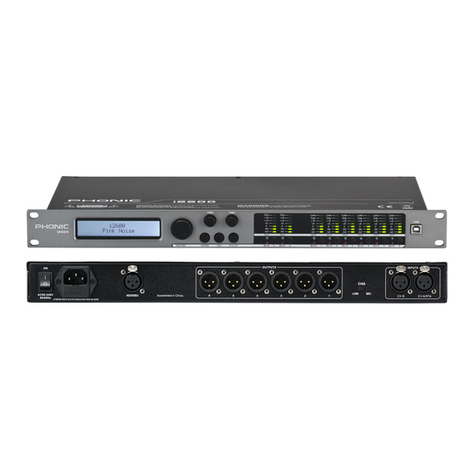
Phonic
Phonic i2600 User manual

Phonic
Phonic MQ3300 User manual

Phonic
Phonic MICRO VI User manual
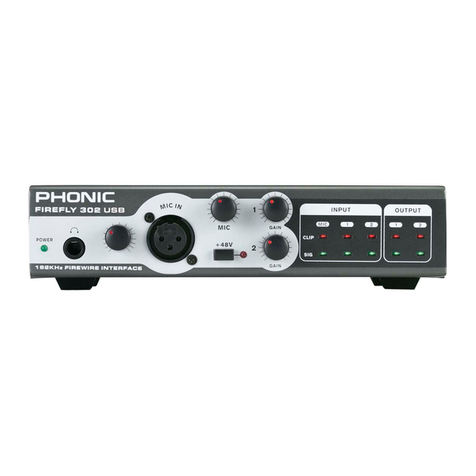
Phonic
Phonic FIREFLY 302 USB User manual

Phonic
Phonic FIREFLY 302 USB User manual

Phonic
Phonic MQ 3229 User manual

Phonic
Phonic i7300 ReverbMaster User manual

Phonic
Phonic DFX256 User manual




